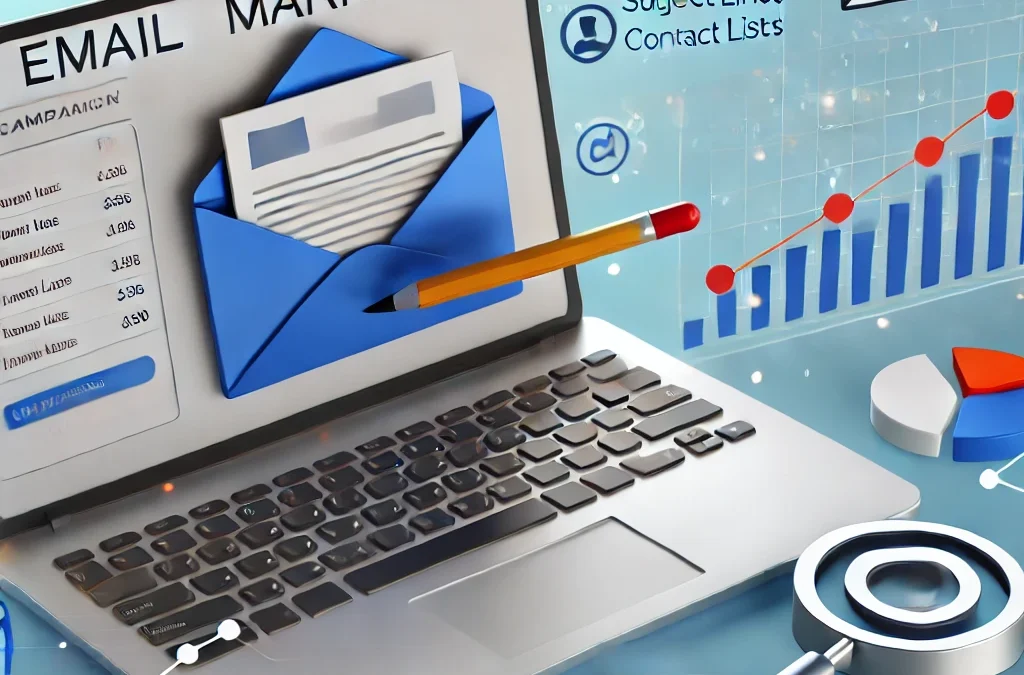Email Marketing That Converts: Tips to Build and Nurture Your Subscriber List
Email marketing remains one of the most effective ways to engage with your audience, nurture leads, and convert them into paying customers. In fact, for every $1 spent on email marketing, the average return is $42, making it a powerful tool for small businesses and entrepreneurs. But to truly reap the benefits, you need a well-thought-out strategy for building and nurturing your subscriber list.
In this guide, we’ll cover the essentials of email marketing, from growing your list to crafting campaigns that convert. Whether you’re just starting or looking to improve your existing efforts, these tips will help you boost your email marketing success.
Why Email Marketing is Important
Unlike social media, where your reach can be limited by platform algorithms, email marketing allows you to reach your audience directly. It’s also a personalized and cost-effective way to keep your brand top of mind and build long-term customer relationships.
Key Benefits of Email Marketing:
- Direct Access: You own your email list, meaning you can communicate with your audience without being at the mercy of third-party algorithms.
- Personalization: Emails can be tailored based on user behavior, preferences, and demographics to increase engagement.
- Automation: With email automation tools, you can set up campaigns that nurture leads over time with minimal ongoing effort.
- Measurable: Email platforms provide detailed analytics that help you track open rates, click-through rates, and conversions.
Step-by-Step Guide to Building and Nurturing Your Subscriber List
1. Build a High-Quality Email List
Before you can launch effective campaigns, you need to build a list of engaged subscribers who are genuinely interested in your business.
- Use Opt-In Forms on Your Website: Add prominent sign-up forms on high-traffic pages like your homepage, blog posts, and checkout pages. Make sure these forms are easy to fill out and offer a compelling reason for visitors to subscribe.
- Offer Lead Magnets: Give people an incentive to sign up by offering free resources such as an ebook, checklist, discount code, or exclusive access to content. This is known as a lead magnet.
- Use Pop-Ups Strategically: Timed pop-ups that appear when a visitor shows intent to leave your site can encourage sign-ups. Ensure the pop-up isn’t disruptive and offers something valuable.
- Leverage Social Media: Promote your email sign-up forms across your social media channels. For example, you can direct Instagram followers to a landing page with a sign-up form.
- Host Contests or Giveaways: Run a contest where participants need to enter their email to qualify for a prize. This is an easy way to quickly grow your list.
Checklist:
- Add opt-in forms to multiple pages on your website.
- Create a lead magnet to attract subscribers.
- Promote your email list on social media and during giveaways.
Related Resources:
2. Create Engaging and Relevant Content
Once you have subscribers, the key to keeping them engaged is to send them relevant and valuable content that meets their needs.
- Welcome Emails: The first email you send to a new subscriber is critical. Welcome emails should introduce your brand, set expectations, and offer a thank-you incentive like a discount code or free resource.
- Segment Your List: Use segmentation to tailor your content based on subscriber behavior, interests, and demographics. For example, segment by purchase history, geographic location, or website activity.
- Use Compelling Subject Lines: Your subject line is what determines whether someone opens your email or not. Make it intriguing, clear, and relevant. A/B test different subject lines to see which ones perform best.
- Offer Value: Every email should offer value to your subscribers, whether that’s helpful tips, exclusive discounts, or interesting insights. Avoid overly promotional content; instead, focus on building a relationship.
- Incorporate Visuals: Use engaging visuals, such as product images, infographics, or videos, to break up text and make your emails more appealing.
Checklist:
- Send a personalized welcome email to each new subscriber.
- Segment your email list to send more relevant content.
- A/B test subject lines and email content to increase open and click-through rates.
Related Resources:
3. Automate Your Email Marketing
Automation allows you to set up email campaigns that run in the background while nurturing leads or engaging with existing customers at the right moments.
- Welcome Series: After the initial welcome email, consider setting up a series of automated emails to further introduce your brand, highlight popular products, and build trust.
- Abandoned Cart Emails: If a customer adds products to their cart but doesn’t complete the purchase, you can send a reminder email with a clear call to action. Offering a discount or free shipping can also encourage them to finalize the purchase.
- Post-Purchase Follow-Up: After a customer makes a purchase, send a follow-up email thanking them and suggesting related products. You can also ask for feedback or encourage them to leave a review.
- Re-engagement Campaigns: For subscribers who haven’t opened your emails in a while, send a re-engagement email offering a special discount or asking if they’d still like to receive emails. This helps keep your list clean and ensures you’re only sending emails to people who are genuinely interested.
Checklist:
- Set up a welcome email series to onboard new subscribers.
- Automate abandoned cart reminders and post-purchase follow-ups.
- Run re-engagement campaigns for inactive subscribers.
Related Resources:
4. Optimize for Deliverability and Performance
To ensure that your emails reach your subscribers’ inboxes (and don’t end up in spam folders), you need to follow best practices for deliverability and track the performance of your campaigns.
- Maintain a Clean List: Regularly clean your email list by removing inactive subscribers and invalid email addresses. This will improve your deliverability rate and keep your engagement metrics high.
- Personalization: Personalize emails by using the subscriber’s first name and sending recommendations based on their behavior. Personalized emails have higher open and click-through rates.
- Optimize for Mobile: Most people read emails on their mobile devices, so it’s important that your emails are responsive and easy to read on small screens. Use concise copy, large buttons, and images that load quickly.
- Track Key Metrics: Use your email platform’s analytics to track important metrics like open rates, click-through rates (CTR), and conversions. If you notice low engagement, you can tweak your content or subject lines.
Checklist:
- Remove inactive subscribers and invalid emails regularly.
- Personalize emails with names and behavior-based recommendations.
- Ensure all emails are mobile-friendly.
- Track email performance and adjust strategies accordingly.
Related Resources:
5. Measure and Improve Your Campaigns
One of the best things about email marketing is that it’s measurable. By analyzing your campaign data, you can learn what works and what doesn’t—and continuously optimize your efforts.
- Open Rate: The percentage of subscribers who opened your email. A high open rate indicates that your subject line was engaging and your content is relevant.
- Click-Through Rate (CTR): The percentage of subscribers who clicked on a link within your email. This shows how effective your content and calls to action are.
- Conversion Rate: The percentage of subscribers who took a desired action, such as making a purchase or signing up for a webinar, after clicking through your email.
- Unsubscribe Rate: If you notice a high unsubscribe rate, it could mean your content isn’t resonating with your audience or that you’re sending too many emails.
By regularly reviewing these metrics, you can refine your email marketing strategy and improve performance over time.
Checklist:
- Track open rates, click-through rates, and conversions.
- Use A/B testing to optimize subject lines and email content.
- Continuously tweak your strategy based on performance data.
Related Resources:
Final Thoughts
Email marketing is a highly effective way to build and nurture relationships with your audience. By focusing on growing a high-quality subscriber list, creating relevant and engaging content, automating key campaigns, and measuring performance, you can create an email marketing strategy that drives results.
Remember, the key to success is consistency. Stay engaged with your subscribers, deliver value with every email, and continually refine your approach based on data. With time and effort, you’ll see your email marketing campaigns convert leads into loyal customers, growing your business in the process.
By following these steps and using the provided resources, you can take your email marketing to the next level, ensuring higher engagement, better relationships, and more conversions.


